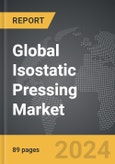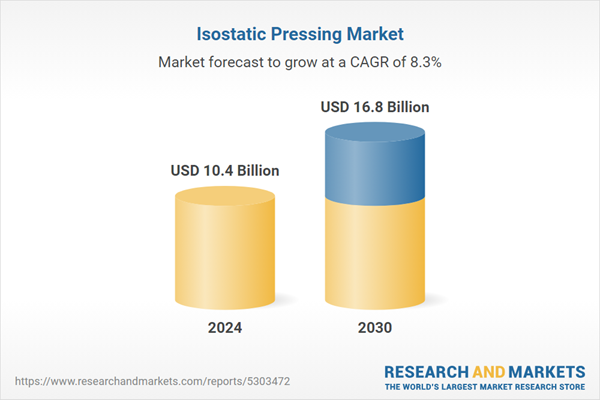The global market for Isostatic Pressing was valued at US$10.4 Billion in 2024 and is projected to reach US$16.8 Billion by 2030, growing at a CAGR of 8.3% from 2024 to 2030. This comprehensive report provides an in-depth analysis of market trends, drivers, and forecasts, helping you make informed business decisions. The report includes the most recent global tariff developments and how they impact the Isostatic Pressing market.
Segments: Component (Systems, Services); Type (Hot, Cold).
Geographic Regions/Countries: World; United States; Canada; Japan; China; Europe (France; Germany; Italy; United Kingdom; Spain; Russia; and Rest of Europe); Asia-Pacific (Australia; India; South Korea; and Rest of Asia-Pacific); Latin America (Argentina; Brazil; Mexico; and Rest of Latin America); Middle East (Iran; Israel; Saudi Arabia; United Arab Emirates; and Rest of Middle East); and Africa.
The analysts continuously track trade developments worldwide, drawing insights from leading global economists and over 200 industry and policy institutions, including think tanks, trade organizations, and national economic advisory bodies. This intelligence is integrated into forecasting models to provide timely, data-driven analysis of emerging risks and opportunities.
Global Isostatic Pressing Market - Key Trends and Drivers Summarized
How Is Isostatic Pressing Revolutionizing Material Manufacturing?
Isostatic pressing is a critical manufacturing process used to densify and shape materials by applying uniform pressure from all directions. This process is widely used in industries such as aerospace, automotive, and medical devices to produce high-strength, complex-shaped components from materials like ceramics, metals, and composites. Cold isostatic pressing (CIP) and hot isostatic pressing (HIP) are the two main types, with HIP being particularly effective for reducing porosity and increasing the mechanical properties of materials. Isostatic pressing is enabling manufacturers to create components with superior density, uniformity, and strength, making it essential for applications that require high-performance materials.What Technological Innovations Are Driving Isostatic Pressing?
Technological advancements in isostatic pressing equipment and materials science are driving the adoption of this process across various industries. Modern HIP systems are equipped with computer controls and automation features, allowing for precise pressure and temperature control, which leads to more consistent and high-quality parts. The development of new composite materials and advanced ceramics is also expanding the range of applications for isostatic pressing, as these materials require uniform pressure to achieve the desired mechanical properties. Furthermore, additive manufacturing (3D printing) is increasingly being integrated with isostatic pressing to produce complex parts with improved material properties, enhancing the overall manufacturing process.How Do Market Segments Define the Growth of Isostatic Pressing?
Types include cold isostatic pressing (CIP) and hot isostatic pressing (HIP), with HIP leading the market due to its ability to improve material properties through high-temperature processing. Applications span across the aerospace, automotive, and medical device sectors, with aerospace being the largest segment as the industry demands high-strength components for critical applications. End-users include aerospace manufacturers, automotive companies, and medical device producers, with aerospace driving the market due to the need for lightweight, high-performance materials in aircraft and spacecraft. The market is growing rapidly in regions such as North America, Europe, and Asia-Pacific, where advanced manufacturing technologies are being adopted.What Factors Are Driving the Growth in the Isostatic Pressing Market?
The growth in the isostatic pressing market is driven by several factors, including the increasing demand for high-performance materials in aerospace and automotive applications, advancements in materials science, and the growing use of additive manufacturing. As industries seek to produce components with superior mechanical properties and reduced porosity, isostatic pressing is becoming a key process in material manufacturing. Technological innovations, such as automated HIP systems and the integration of 3D printing, are further propelling market growth by enhancing the efficiency and precision of the isostatic pressing process. Additionally, the rising demand for lightweight materials in the aerospace industry and the need for durable medical implants are contributing to the expansion of the market.Report Scope
The report analyzes the Isostatic Pressing market, presented in terms of units. The analysis covers the key segments and geographic regions outlined below.Segments: Component (Systems, Services); Type (Hot, Cold).
Geographic Regions/Countries: World; United States; Canada; Japan; China; Europe (France; Germany; Italy; United Kingdom; Spain; Russia; and Rest of Europe); Asia-Pacific (Australia; India; South Korea; and Rest of Asia-Pacific); Latin America (Argentina; Brazil; Mexico; and Rest of Latin America); Middle East (Iran; Israel; Saudi Arabia; United Arab Emirates; and Rest of Middle East); and Africa.
Key Insights:
- Market Growth: Understand the significant growth trajectory of the Systems segment, which is expected to reach US$9.4 Billion by 2030 with a CAGR of a 7.9%. The Services segment is also set to grow at 8.8% CAGR over the analysis period.
- Regional Analysis: Gain insights into the U.S. market, valued at $2.7 Billion in 2024, and China, forecasted to grow at an impressive 12.0% CAGR to reach $4.1 Billion by 2030. Discover growth trends in other key regions, including Japan, Canada, Germany, and the Asia-Pacific.
Why You Should Buy This Report:
- Detailed Market Analysis: Access a thorough analysis of the Global Isostatic Pressing Market, covering all major geographic regions and market segments.
- Competitive Insights: Get an overview of the competitive landscape, including the market presence of major players across different geographies.
- Future Trends and Drivers: Understand the key trends and drivers shaping the future of the Global Isostatic Pressing Market.
- Actionable Insights: Benefit from actionable insights that can help you identify new revenue opportunities and make strategic business decisions.
Key Questions Answered:
- How is the Global Isostatic Pressing Market expected to evolve by 2030?
- What are the main drivers and restraints affecting the market?
- Which market segments will grow the most over the forecast period?
- How will market shares for different regions and segments change by 2030?
- Who are the leading players in the market, and what are their prospects?
Report Features:
- Comprehensive Market Data: Independent analysis of annual sales and market forecasts in US$ Million from 2024 to 2030.
- In-Depth Regional Analysis: Detailed insights into key markets, including the U.S., China, Japan, Canada, Europe, Asia-Pacific, Latin America, Middle East, and Africa.
- Company Profiles: Coverage of players such as Abra Fluid, American Isostatic Presses (AIP), Arconic, Bodycote, Crystal Technologies and more.
- Complimentary Updates: Receive free report updates for one year to keep you informed of the latest market developments.
Some of the 33 companies featured in this Isostatic Pressing market report include:
- Abra Fluid
- American Isostatic Presses (AIP)
- Arconic
- Bodycote
- Crystal Technologies
- Dorst Technologies
- Engineered Pressure Systems (EPSI)
- Fluitron
- Frey & Co.
- Ilshin Autoclave
- Insmart Systems
- Kennametal
- Kittyhawk Products
- Kobe Steel
- Nikkiso
- Pressure Technology
- Quad City Manufacturing Laboratory (QCML)
- Sandvik Powder Solutions AB
- Shanxi Golden Kaiyuan
- Tianjin Taipingyang Mecha-Electronic Technique & Equipment
Tariff Impact Analysis: Key Insights for 2025
Global tariff negotiations across 180+ countries are reshaping supply chains, costs, and competitiveness. This report reflects the latest developments as of April 2025 and incorporates forward-looking insights into the market outlook.The analysts continuously track trade developments worldwide, drawing insights from leading global economists and over 200 industry and policy institutions, including think tanks, trade organizations, and national economic advisory bodies. This intelligence is integrated into forecasting models to provide timely, data-driven analysis of emerging risks and opportunities.
What’s Included in This Edition:
- Tariff-adjusted market forecasts by region and segment
- Analysis of cost and supply chain implications by sourcing and trade exposure
- Strategic insights into geographic shifts
Buyers receive a free July 2025 update with:
- Finalized tariff impacts and new trade agreement effects
- Updated projections reflecting global sourcing and cost shifts
- Expanded country-specific coverage across the industry
Table of Contents
I. METHODOLOGYII. EXECUTIVE SUMMARY2. FOCUS ON SELECT PLAYERSIII. MARKET ANALYSISSOUTH KOREAREST OF ASIA-PACIFICARGENTINABRAZILMEXICOREST OF LATIN AMERICAIRANISRAELSAUDI ARABIAUNITED ARAB EMIRATESREST OF MIDDLE EASTIV. COMPETITION
1. MARKET OVERVIEW
3. MARKET TRENDS & DRIVERS
4. GLOBAL MARKET PERSPECTIVE
UNITED STATES
CANADA
JAPAN
CHINA
EUROPE
FRANCE
GERMANY
ITALY
UNITED KINGDOM
SPAIN
RUSSIA
REST OF EUROPE
ASIA-PACIFIC
AUSTRALIA
INDIA
LATIN AMERICA
MIDDLE EAST
AFRICA
Companies Mentioned (Partial List)
A selection of companies mentioned in this report includes, but is not limited to:
- Abra Fluid
- American Isostatic Presses (AIP)
- Arconic
- Bodycote
- Crystal Technologies
- Dorst Technologies
- Engineered Pressure Systems (EPSI)
- Fluitron
- Frey & Co.
- Ilshin Autoclave
- Insmart Systems
- Kennametal
- Kittyhawk Products
- Kobe Steel
- Nikkiso
- Pressure Technology
- Quad City Manufacturing Laboratory (QCML)
- Sandvik Powder Solutions AB
- Shanxi Golden Kaiyuan
- Tianjin Taipingyang Mecha-Electronic Technique & Equipment
Table Information
| Report Attribute | Details |
|---|---|
| No. of Pages | 89 |
| Published | April 2025 |
| Forecast Period | 2024 - 2030 |
| Estimated Market Value ( USD | $ 10.4 Billion |
| Forecasted Market Value ( USD | $ 16.8 Billion |
| Compound Annual Growth Rate | 8.3% |
| Regions Covered | Global |









